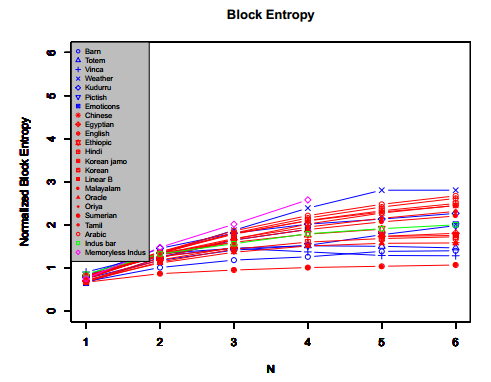Linguistic Society of America
Source - http://www.eurekalert.org/pub_releases/2014-06/lsoa-nac052814.php

Block entropy values for our linguistic and nonlinguistic corpora, the Indus bar seal corpus, and our memoryless Indus corpus. As in Rao’s case, we used the method reported in Nemenman et al. 2001. Note that the method became unstable for the two highest n-gram values for the memoryless Indus corpus.
New research published in the June 2014 issue of Language presents evidence that the methods employed by the authors of articles published in prestigious international science journals are not supported by a more rigorous linguistic analysis. The Language article, "A statistical comparison of written language and non-linguistic symbol systems," was authored by Richard Sproat, a Research Scientist at Google, based on work he previously did at the Oregon Health & Science University. A pre-print version of the article is available for review at: http://www.linguisticsociety.org/document/language-vol-90-issue-2-june-2014-sproat.

Indus repetitions, from Farmer et al. 2004, figure 6. As described there, these are: ‘Examples of the most common types of Indus sign repetition. … The most frequent repeating Indus symbol is the doubled sign illustrated in M-382 A, which is sometimes claimed to represent a field or building, based on Near Eastern parallels. The sign is often juxtaposed (as here) with a human or divine figure carrying what appears to be one (or in several other cases) four sticks. M-634 a illustrates a rare type of sign repetition that involves three duplications of the so-called wheel symbol, which other evidence suggests in some cases served as a sun/ power symbol; the sign shows up no less than four times on the badly deteriorated Dholavira signboard (not shown), which apparently once hung over (or guarded?) the main gate to the city’s inner citadel. The color photo of MD-1429 is reproduced from M. Kenoyer, Ancient Cities of the Indus Valley Civilization, Oxford University Press, Oxford 1998, p. 85, exhibition catalog number MD 602. The sign on either side of the oval symbols in the inscription is the most common symbol in the Indus corpus, making up approximately 10% of all symbol cases; despite its high general frequency, repetitions of the symbol in single inscriptions, of the kind seen here, are relatively rare.’
Sproat's analysis comes in response to a number of papers published in high-profile science publications that have argued that statistical analyses of symbol combinations can provide insights into the origins of written language. One paper, by Rajesh Rao (University of Washington), Iravatham Mahadevan (Indus Research Centre) and colleagues at the TATA Institute in Mumbai, India, appeared in 2009 in the journal Science. It argued that a particular statistical measure — bigram conditional entropy — showed that the Indus Valley symbols behave more like those in linguistic texts than those of non-linguistic systems. In another paper in the Proceedings of the Royal Society, Rob Lee and colleagues (University of Exeter) claimed that a more sophisticated set of entropic measures put Pictish symbols in the same category as linguistic texts. Both papers (and other subsequent papers by Rao and his colleagues) received a large amount of attention from the news media. In these popular media accounts, the techniques were often presented as demonstrating that the symbol systems in question were written language, though this was not necessarily the intention of the authors.
Understanding statistical techniques for analyzing symbol systems and what they do and do not show is of fundamental importance to language science, as there are many old or ancient symbol systems whose function is largely or completely unknown. Examples include the Easter Island rongorongo inscriptions (19th century), the Pictish symbols of Scotland (6th century onwards), and the Indus Valley symbols (Northern India, Pakistan, 3rd millennium BCE). As part of his work on the question of whether symbol systems such as these exemplify written language, Sproat developed large, structured collections of text, or corpora, from a variety of non-linguistic systems, both ancient and modern, including Mesopotamian deity symbols (Babylonia), Totem poles (Pacific Northwest), Pennsylvania barn stars ("hex signs"), weather forecast icon sequences from http://www.wunderground.com, and Unicode characters for Asian emoticons. He compared these to corpora developed from fourteen languages representing a variety of different writing-system types, both ancient and modern.
From the point of view of the measures that had been proposed in the previous literature, all of the non-linguistic symbol systems in Sproat's collection or corpora behaved the same as the linguistic systems. However, he also found that a novel measure of the amount of local repetition and a version of one of Lee and colleagues' entropic measures with a different setting than they used could accurately distinguish two different categories of symbol systems. Moreover, his statistical procedure, unlike the earlier ones, classifies both the Pictish and Indus Valley symbols as non-linguistic.
Despite these promising results, Sproat cautions against relying too heavily on statistical measures to analyze ancient symbol systems that have not been deciphered. All statistical measures are heavily influenced by, among other things, the size of the corpus, the length of texts, and what kind of text is involved. Shopping lists, for example, have statistical properties that distinguish them from running prose from a novel. He argues that a truly reliable demonstration that a collection of symbols exemplifies written language requires supporting empirical evidence, such as a credible decipherment or independent archeological evidence of a related culture of active literacy. What is clear, however, is that the previously proposed statistical methods simply do not work for the intended purpose.